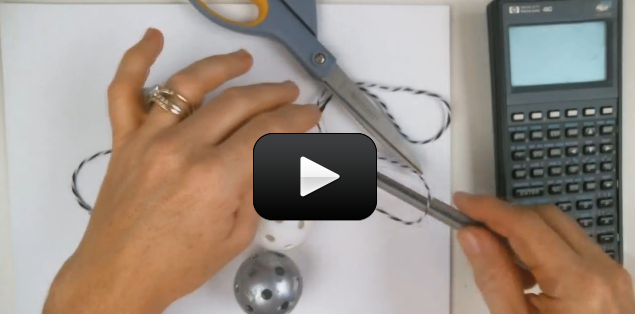This experiment is for advanced students. Circular motion is a little different from straight-line motion in a few different ways. Objects that move in circles are roller coasters in a loop, satellites in orbit, DVDs spinning in a player, kids on a merry go round, solar systems rotating in the galaxy, making a left turn in your car, water through a coiled hose, and so much more.
Velocity is always tangent to the circle in the direction of the motion, and acceleration is always directed radially inward. Because of these two things, the acceleration that arises from traveling in a circle is called centripetal acceleration (a word created by Sir Isaac Newton). There’s no direct relationship between the acceleration and velocity vectors for a moving particle.
[am4show have='p8;p9;p11;p38;p92;p38;p90;p44;' guest_error='Guest error message' user_error='User error message' ] If you have a bucket of water and you’re swinging it around your head, in order to keep a bucket of water swinging in a circle, the centripetal force can be felt in the tension experienced by the handle. Swinging an object around on a string will cause the rope to undergo tension (centripetal force), and if your rope isn’t strong enough, it will snap and break, sending the mass flying off in a tangential straight line until gravity and drag force pull the object to a stop.
Here’s a cool experiment you can do that will really show you how objects that move in a circle experience centripetal force. You can lift at least 10 balls by using only one! All you need are balls, fishing line or dental floss, and an old pen.
Download Student Worksheet!
Remember Newton’s First Law? The law of inertia? It states that objects in motion tend to stay in motion with the same speed and direction unless acted upon by an unbalanced/external force. Which means that objects naturally want to continue going their straight and merry way (like you did in a straight line when you were inside the car) until an unbalanced force causes it to turn speed up or stop. Can you see how an unbalanced force is required for objects to move in a circle? There has to be a force pushing on the object, keeping in on a circular path because otherwise, it’ll go off in a straight line!
There's a whole section just on circular motion in our advanced section here. [/am4show]
Velocity is always tangent to the circle in the direction of the motion, and acceleration is always directed radially inward. Because of these two things, the acceleration that arises from traveling in a circle is called centripetal acceleration (a word created by Sir Isaac Newton). There’s no direct relationship between the acceleration and velocity vectors for a moving particle.
[am4show have='p8;p9;p11;p38;p92;p38;p90;p44;' guest_error='Guest error message' user_error='User error message' ] If you have a bucket of water and you’re swinging it around your head, in order to keep a bucket of water swinging in a circle, the centripetal force can be felt in the tension experienced by the handle. Swinging an object around on a string will cause the rope to undergo tension (centripetal force), and if your rope isn’t strong enough, it will snap and break, sending the mass flying off in a tangential straight line until gravity and drag force pull the object to a stop.
Here’s a cool experiment you can do that will really show you how objects that move in a circle experience centripetal force. You can lift at least 10 balls by using only one! All you need are balls, fishing line or dental floss, and an old pen.
Download Student Worksheet!
Remember Newton’s First Law? The law of inertia? It states that objects in motion tend to stay in motion with the same speed and direction unless acted upon by an unbalanced/external force. Which means that objects naturally want to continue going their straight and merry way (like you did in a straight line when you were inside the car) until an unbalanced force causes it to turn speed up or stop. Can you see how an unbalanced force is required for objects to move in a circle? There has to be a force pushing on the object, keeping in on a circular path because otherwise, it’ll go off in a straight line!
There's a whole section just on circular motion in our advanced section here. [/am4show]


Feel free to send an email if you need help! Mass is “m” and gravity is “g”. If you’re using metric (like kilograms and meters), then g = 9.81 m/s^2.
Aurora what does m and g mean I am sorry I am just so confused I am confused.